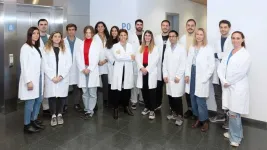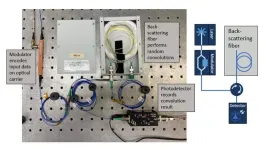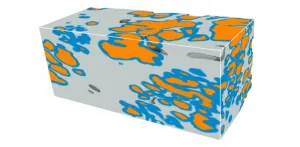(Press-News.org) CAMBRIDGE, MA -- MIT chemists have designed a sensor that detects tiny quantities of perfluoroalkyl and polyfluoroalkyl substances (PFAS) — chemicals found in food packaging, nonstick cookware, and many other consumer products.
These compounds, also known as “forever chemicals” because they do not break down naturally, have been linked to a variety of harmful health effects, including cancer, reproductive problems, and disruption of the immune and endocrine systems.
Using the new sensor technology, the researchers showed that they could detect PFAS levels as low as 200 parts per trillion in a water sample. The device they designed could offer a way for consumers to test their drinking water, and it could also be useful in industries that rely heavily on PFAS chemicals, including the manufacture of semiconductors and firefighting equipment.
“There’s a real need for these sensing technologies. We’re stuck with these chemicals for a long time, so we need to be able to detect them and get rid of them,” says Timothy Swager, the John D. MacArthur Professor of Chemistry at MIT and the senior author of the study, which appears this week in the Proceedings of the National Academy of Sciences.
Other authors of the paper are former MIT postdoc and lead author Sohyun Park and MIT graduate student Collette Gordon.
Detecting PFAS
Coatings containing PFAS chemicals are used in thousands of consumer products. In addition to nonstick coatings for cookware, they are also commonly used in water-repellent clothing, stain-resistant fabrics, grease-resistant pizza boxes, cosmetics, and firefighting foams.
These fluorinated chemicals, which have been in widespread use since the 1950s, can be released into water, air, and soil, from factories, sewage treatment plants, and landfills. They have been found in drinking water sources in all 50 states.
In 2023, the Environmental Protection Agency created an “advisory health limit” for two of the most hazardous PFAS chemicals, known as perfluorooctanoic acid (PFOA) and perfluorooctyl sulfonate (PFOS). These advisories call for a limit of 0.004 parts per trillion for PFOA and 0.02 parts per trillion for PFOS in drinking water.
Currently, the only way that a consumer could determine if their drinking water contains PFAS is to send a water sample to a laboratory that performs mass spectrometry testing. However, this process takes several weeks and costs hundreds of dollars.
To create a cheaper and faster way to test for PFAS, the MIT team designed a sensor based on lateral flow technology — the same approach used for rapid Covid-19 tests and pregnancy tests. Instead of a test strip coated with antibodies, the new sensor is embedded with a special polymer known as polyaniline, which can switch between semiconducting and conducting states when protons are added to the material.
The researchers deposited these polymers onto a strip of nitrocellulose paper and coated them with a surfactant that can pull fluorocarbons such as PFAS out of a drop of water placed on the strip. When this happens, protons from the PFAS are drawn into the polyaniline and turn it into a conductor, reducing the electrical resistance of the material. This change in resistance, which can be measured precisely using electrodes and sent to an external device such as a smartphone, gives a quantitative measurement of how much PFAS is present.
This approach works only with PFAS that are acidic, which includes two of the most harmful PFAS — PFOA and perfluorobutanoic acid (PFBA).
A user-friendly system
The current version of the sensor can detect concentrations as low as 200 parts per trillion for PFBA, and 400 parts per trillion for PFOA. This is not quite low enough to meet the current EPA guidelines, but the sensor uses only a fraction of a milliliter of water. The researchers are now working on a larger-scale device that would be able to filter about a liter of water through a membrane made of polyaniline, and they believe this approach should increase the sensitivity by more than a hundredfold, with the goal of meeting the very low EPA advisory levels.
“We do envision a user-friendly, household system,” Swager says. “You can imagine putting in a liter of water, letting it go through the membrane, and you have a device that measures the change in resistance of the membrane.”
Such a device could offer a less expensive, rapid alternative to current PFAS detection methods. If PFAS are detected in drinking water, there are commercially available filters that can be used on household drinking water to reduce those levels. The new testing approach could also be useful for factories that manufacture products with PFAS chemicals, so they could test whether the water used in their manufacturing process is safe to release into the environment.
###
The research was funded by an MIT School of Science Fellowship to Gordon, a Bose Research Grant, and a Fulbright Fellowship to Park.
END
A new sensor detects harmful “forever chemicals” in drinking water
The technology could offer a cheap, fast way to test for PFAS, which have been linked to cancer and other health problems.
2024-03-11
ELSE PRESS RELEASES FROM THIS DATE:
Robotic interface masters a soft touch
2024-03-11
The perception of softness can be taken for granted, but it plays a crucial role in many actions and interactions – from judging the ripeness of an avocado to conducting a medical exam, or holding the hand of a loved one. But understanding and reproducing softness perception is challenging, because it involves so many sensory and cognitive processes.
Robotics researchers have tried to address this challenge with haptic devices, but previous attempts have not distinguished between two primary elements of softness perception: cutaneous cues (sensory feedback ...
Tuberculosis bacteria also present in 90% of those with symptoms, who are not diagnosed with TB
2024-03-11
Mycobacterium tuberculosis (Mtb), the bacteria that causes a tuberculosis infection, is present in exhaled breath of 90% of those presenting with suspected tuberculosis. This includes those who were negative on conventional sputum testing and not diagnosed with TB. This raises the possibility that those who have tested negative may be unknowingly transmitting the infection. Researchers from the University of Cape Town and Amsterdam UMC analysed results from over 100 patients who presented themselves to clinics in South Africa. These findings are published today in PNAS.
“If ...
U of M-led study reveals shared blueprint in brain development across different functional areas
2024-03-11
In a new study published in Proceedings of the National Academy of Sciences (PNAS), researchers from the University of Minnesota Medical School investigated brain development to understand how different areas of the brain become specialized in handling information such as vision, sound, touch and planning.
The study found that different areas of the brain start with a similar organization rather than already being specialized in early development. This suggests that the brain might use a single shared blueprint to guide early development.
“Throughout life, the brain continually builds on the foundations set ...
Researchers solve crucial cold-induced sweetening problem in potato production
2024-03-11
Researchers have discovered a game changer for the potato industry.
According to a new study published in a leading international society journal published by the American Society of Plant Biologists, a small genetic element is the cause of a major production problem in potatoes.
“Our manuscript reveals the mystery of “cold-induced sweetening” (CIS), the most troublesome and expensive problem for the potato processing industry,” explained Jiming Jiang, Corresponding Author of “Molecular dissection of an intronic enhancer governing cold-induced expression ...
Developed by VHIO, a novel AI-based and non-invasive diagnostic tool enables accurate brain tumor diagnosis, outperforming current classification methods
2024-03-11
Developed by VHIO, a novel AI-based and non-invasive diagnostic tool enables accurate brain tumor diagnosis, outperforming current classification methods
Developed by VHIO’s Radiomics Group in close collaboration with researchers of the Neuroradiology Unit at the Bellvitge University Hospital (HUB), DISCERN is a deep learning tool that leverages information of magnetic resonance imaging and facilitates brain tumor classification to aid clinical decision making.
Currently, a definitive diagnosis often requires neurosurgical interventions that compromise the quality of life of patients.
Trained to differentiate between the three most ...
Natural history specimens have never been so accessible
2024-03-11
With the help of 16 grants from the National Science Foundation, researchers have painstakingly taken computed topography (CT) scans of more than 13,000 individual specimens to create 3D images of more than half of all the world's animal groups, including mammals, fishes, amphibians and reptiles.
The research team, made of members from The University of Texas at Arlington and 25 other institutions, are now a quarter of the way through inputting nearly 30,000 media files to the open-source repository MorphoSource. This will allow researchers ...
NRL research physicists explore fiber optic computing using distributed feedback
2024-03-11
WASHINGTON – U.S. Naval Research Laboratory (NRL) researchers deliver novel contribution in fiber optics computing, Fiber Optic Computing Using Distributed Feedback paper recently published in Communications Physics journal, brings the Navy one step closer to faster, more efficient computing technologies.
Optical computing uses the properties of light, such as its speed and ability to carry large amounts of data, to process information more efficiently than traditional electronic computers.
In collaboration with Sandia National Laboratories and the University of Central Florida, NRL is aiming ...
Canals used to drain peatlands are underappreciated hotspots for carbon emissions
2024-03-11
A new study led by UC San Diego Scripps Institution of Oceanography postdoctoral scholar Jennifer Bowen finds that canals used to drain soggy peatlands in Southeast Asia are likely hotspots for greenhouse gas emissions.
The results, published March 8 in Nature Geoscience and supported by the Scripps Institutional Postdoctoral Program and Stanford University’s Precourt Institute for Energy, identify a previously unaccounted for source of emissions from these threatened, carbon-rich landscapes. Findings from the study suggest that the degradation of tropical peatlands in Southeast Asia has released even more planet-warming ...
Nutritional value of meat should be considered when comparing carbon footprints
2024-03-11
The nutritional value of meat must be considered when comparing carbon footprints – that is the key message from a recent study undertaken by Hybu Cig Cymru – Meat Promotion Wales (HCC), Bangor University, Queen’s University, and the Agri-Food and Biosciences Institute (AFBI).
The scientific paper, published in the journal Frontiers in Sustainable Food Systems using data from the Welsh Lamb Meat Quality project, focuses on different lamb production systems, specifically the ‘finishing’ period – at the end of which lambs have reached the required weight, meat and fat cover for ...
Microscopy plus deep learning to advance prostate cancer diagnosis
2024-03-11
Prostate cancer stands as a prevalent threat to men's health, ranking second in cancer-related deaths in the United States. Each year, approximately 250,000 men in the U.S. receive a prostate cancer diagnosis. While most cases have low morbidity and mortality rates, a subset of cases demands aggressive treatment. Urologists assess the need for such treatment primarily through the Gleason score, which evaluates prostate gland appearance on histology slides. However, there's considerable variability in interpretation, leading to both undertreatment and overtreatment.
The current method, based on histology ...
LAST 30 PRESS RELEASES:
Mapping ‘dark’ regions of the genome illuminates how cells respond to their environment
ECOG-ACRIN and Caris Life Sciences unveil first findings from a multi-year collaboration to advance AI-powered multimodal tools for breast cancer recurrence risk stratification
Satellite data helps UNM researchers map massive rupture of 2025 Myanmar earthquake
Twisting Spins: Florida State University researchers explore chemical boundaries to create new magnetic material
Mayo Clinic researchers find new hope for toughest myeloma through off-the-shelf immunotherapy
Cell-free DNA Could Detect Adverse Events from Immunotherapy
American College of Cardiology announces Fuster Prevention Forum
AAN issues new guideline for the management of functional seizures
Could GLP-1 drugs affect risk of epilepsy for people with diabetes?
New circoviruses discovered in pilot whales and orcas from the North Atlantic
Study finds increase in risk of binge drinking among 12th graders who use 2 or more cannabis products
New paper-based technology could transform cancer drug testing
Opioids: clarifying the concept of safe supply to save lives
New species of tiny pumpkin toadlet discovered in Brazil highlights need for conservation in the mountain forests of Serra do Quiriri
Reciprocity matters--people were more supportive of climate policies in their country if they believed other countries were making significant efforts themselves
Stanford Medicine study shows why mRNA-based COVID-19 vaccines can cause myocarditis
Biobanking opens new windows into human evolution
Sky-high smoke
AI tips off scientists to new drug target to fight, treat mpox
USC researchers develop next-generation CAR T cells that show stronger, safer response in animal models
New study reveals Industrial Revolution’s uneven health impacts across England
Vine-inspired robotic gripper gently lifts heavy and fragile objects
Fingerprint of ancient seafarer found on Scandinavia’s oldest plank boat
Lunar soil analyses reveal how space weathering shapes the Moon’s ultraviolet reflectance
Einstein’s theory comes wrapped up with a bow: astronomers spot star “wobbling” around black hole
Danforth Plant Science Center to lead multi-disciplinary research to enhance stress resilience in bioenergy sorghum
Home-delivered groceries improve blood sugar control for people with diabetes facing food insecurity
MIT researchers identified three cognitive skills we use to infer what someone really means
The Iberian Peninsula is rotating clockwise according to new geodynamic data
SwRI, Trinity University to study stable bacterial proteins in search of medical advances
[Press-News.org] A new sensor detects harmful “forever chemicals” in drinking waterThe technology could offer a cheap, fast way to test for PFAS, which have been linked to cancer and other health problems.





